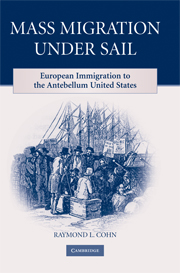Book contents
- Frontmatter
- Contents
- List of Tables and Figures
- Preface
- 1 A Unique Period for Immigration
- 2 The Onset and European Origins of Mass Immigration
- 3 The Jump in Immigrant Volume Around 1830
- 4 Push, Pull, and Other Factors in Antebellum Immigration
- 5 Who Were the Immigrants?
- 6 The Trip from Europe to the United States
- 7 The Immigrants in the United States
- 8 The Effects of Immigration on the United States
- 9 The End of Mass Migration Under Sail
- References
- Index
6 - The Trip from Europe to the United States
Published online by Cambridge University Press: 30 June 2009
- Frontmatter
- Contents
- List of Tables and Figures
- Preface
- 1 A Unique Period for Immigration
- 2 The Onset and European Origins of Mass Immigration
- 3 The Jump in Immigrant Volume Around 1830
- 4 Push, Pull, and Other Factors in Antebellum Immigration
- 5 Who Were the Immigrants?
- 6 The Trip from Europe to the United States
- 7 The Immigrants in the United States
- 8 The Effects of Immigration on the United States
- 9 The End of Mass Migration Under Sail
- References
- Index
Summary
By the end of the nineteenth century, a journey from almost anywhere in Europe to the United States took about ten days – a few days by rail to an embarkation port and about a week on a steamship. A sizeable portion of the immigration that occurred was thus temporary, as many individuals found it easy to come to the United States to work for a season or a few years and then return home. During the antebellum years, however, few actual immigrants – as opposed to merchants or soldiers – anticipated returning to Europe, and the evidence shows that few did. Moving between Europe and the United States at this time involved a much longer trip. The immigrants first had to get from their farm or village to a port from which they could leave, arrange for and wait for passage on a sailing ship, and then endure the long voyage across the Atlantic Ocean. These aspects of the immigrant's trip are examined in this chapter. Included is information on internal transportation within Europe, data on which cities served as major embarkation ports and why they did, and the regulations imposed on the process by the various governments. The immigrants' experience onboard the ship is examined, especially with respect to the mortality suffered, along with the mortality they experienced immediately after arrival. The entire discussion explains why few immigrants wished to repeat the trip to return to Europe.
- Type
- Chapter
- Information
- Mass Migration under SailEuropean Immigration to the Antebellum United States, pp. 125 - 154Publisher: Cambridge University PressPrint publication year: 2008

